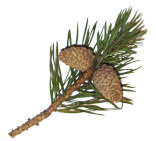Volume IV, Number XL. (COUNTY OF MORAY)
By the Rev. Mr Francis Grant.
[Biographical Notes for the Minister mostly adapted
from the Fasti ecclesiae Scoticanae
FRANCIS GRANT (d.1805) licensed by the Presbytery of Forres 2nd July 1776; ordained
by the Presbytery of Fordyce as missionary at Enzie 11th May 1785; presented
(to Knockando) by Sir James Grant of Grant before 20th June, and admitted 14th
August 1788.
He married, 4th February 1785, Jane Stuart, who died 25th August 1839, aged
80, and had issue —
Agnes, born 7th November 1785;
Helen, born 2nd August 1788;
Jean, born 15th October 1789, died 13th January 1837;
Elizabeth, born 16th September 1791;
Patrick John, born 14th April 1796.
Editor’s addition: Presumed other Publication: the “Birkenburn MS”
history of the Grants.]
Name, Situation, Extent, Soil, Etc.
[302] KNOCKANDOW has its name from two Celtic words, Knock, signifying ‘hill’, and Dow, ‘black.’It is situated in the county of Moray, presbytery of Aberdour and Synod of Moray, about 10 miles in length, and, at an average, 2 in breadth. It is bounded on the S. and S.W. by the parishes of Inveraven and Aberdour, from which it is separated by the river Spey, one of the most rapid in Scotland; on the E. by Rothes, on the N. by Birnie and Dallas, on the W. by Edinkilly and Cromdale.
The country is hilly; the soil either deep moss or sandy gravel; the air dry and healthy.
Spey is the only river connected with the parish, which produces salmon; but owing to cruives, few of them get up this length. The hills are covered with heath, and the river-side with birch, oak and alder. The many small rivulets that descend from the hills, are frequently in the months of February and November swelled by the rains, overflow their banks, and do considerable harm. This happened particularly in 1783, when [303] a water-spout, there is reason to believe, fell in the adjacent hills.
Population
According to Dr Webster’s return, the numbers were 1267. The population is rather less than about 25 years ago, many having gone to Aberdeen. The number of all ages at present is about 1500; of whom 600 are males, and 900 females. The annual average of births is 40, of marriages 12. The number of souls under 10 is 460, and from 70 to 100 is 36.Agriculture
The grain principally cultivated is black oats, big, or Scotch bear, some rye, turnip and potatoes. There is very little artificial grass. Seed-time generally begins in the end of March, and continues through the whole of April. Harvest here is in August, September and October.The land-rent of the parish is about £2000. The fishings produce about £10 a-year.
The number of horses 300, of cattle 3000, of sheep 5000.
There may be about 150 ploughs, all of the Scotch kind, except one. The last in general are very bad. The very best arable land is 14s. the acre; the general size of farms about 30 acres.
Stipend, Poor, Etc.
The value of the living, including the glebe, is £85 Sterling. Sir James Grant of Grant is patron. The Church was built in 1757, and the manse in 1767. There are 4 heritors.The number of poor is 20. This collections for their relief are about £3; and the fines of delinquents, with what arises from a mortification, may amount to £7.
Prices and Wages
Provisions formerly were very cheap. A fat ox might have been got for £1:5s. and a sheep for 3s.4d.; a boll of oat-meal for 6s.8d. Now, beef and [304] mutton fell at 3d. the pound, meal at 14s the boll, and fowls, which sold at 2d. cost 6d. and 7d.A labourer will earn 6d. a-day in summer, and 4d. in winter, including victuals. A common labourer, when married, could never maintain his family, if he had not a small croft. The description of men, in general, is in great poverty. A man servant earns from £4:10s.to £5 a-year, and a woman £1:13:4.
Miscellaneous Observations
The Gaelic was generally spoken here till about 50 years ago.
Peats are the only fuel.
The general size of the people is bout 5 feet 6 inches, and their complexion black. Many of them are very deficient in industry, but economical. They are fond of a military life, and prefer the Highland regiments.
The roads in the parish were formerly well made, and kept in good repair; but, for some time past, they have been greatly neglected. The people, sensible of this neglect, pay the statute-labour in kind, and work, it may be supposed, as little as possible. Were a more liberal plan of management adopted, and the statute-labour commuted, it would be more agreeable, and of much advantage. The people here have no idea of turnpikes, or their advantages.
In 1782, there was neither a sufficiency of feed nor bread, and had not Government interfered, numbers must have starved; but the supply granted, relieved, in a great degree, their wants.
The parish, in general, is uninclosed. The people are sensible of the advantage of inclosures, but they are little encouraged, except by one of the heritors. The condition of the people might be much meliorated, by granting them leases for 38 years, and a lifetime, by encouraging inclosures, and giving them good examples of husbandry.
